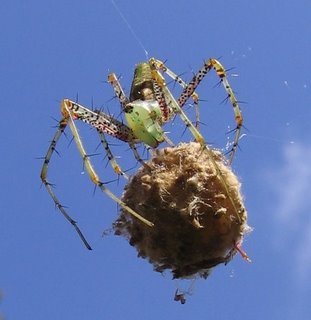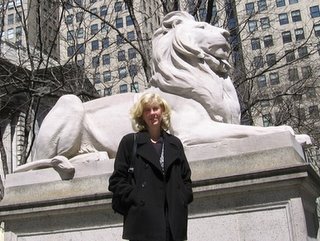Saturday, December 02, 2006
...And the answer key
Here's the Powerpoint with most of the answers marked. Hope studying is going well!
Thursday, November 30, 2006
Fabulous Bio93 Review Competition!
Monday, November 27, 2006
Best review packet for Bio 93

Do you feel overwhelmed by the material you need to study for Bio93? Do you wish someone would tell you what's important from each lecture? Do you want to start studying now, but don't know what to do besides re-reading your notes? I've got the answer! A Bio93 Wiki!
No, sorry. I'm not going to write you up a big list of every important topic from each lecture. But I do think that creating a review sheet is a good study skill. So let's work together to make an online, editable review sheet. I have 90 students, and there are 29 lectures. So... why don't you work on making a review sheet for one lecture, and other students can make one for other lectures, and you can build a really big review sheet? Work on this as much as you like, and I will check the wiki regularly and make corrections and suggestions as you donate.
I've set up the wiki here: http://bio-93.wikispaces.com/
I set up the lecture headings already. Anyone can edit the space, so give it a whirl and let's see if it is helpful to you all.
Thursday, November 16, 2006
Week 8 - Messing with DNA

Hi all! Let's see how well you can manipulate DNA and your notes this week. Print out the Week 8 worksheet here, and bring it and ALL your notes since the midterm to discussion tomorrow.
Wednesday, November 15, 2006
Quiz Results 2
Monday, November 13, 2006
Quiz results

Hi all!
Most of you did very well on the online quiz. The question missed most often was the one about what TATA boxes and poly-A tails are made out of. Some of you were a bit floored by the pedigree too! I've written up a quiz answer key and posted it here. Look over my explanations and tell me if you still need help.
Thursday, November 02, 2006
What's the plot of this story?

We have a new instructor now, and we have a new series of topics. Take a minute to think about where we've been, and where we are going.
First, we learned about what is inside a cell. You learned about the important biological molecules, and how they interact inside and outside the cell. You learned about how cells make and use energy. Then we started talking about mitosis, and meiosis, and now genes.... what's the story here?
Imagine the class is attempting to give you all the information you need to understand how an organism grows from a fused egg and sperm. You need to know:
1. How cells function in the mature organism - making proteins, maintaining electrochemical gradients, secreting signals into the blood, etc.
2. How cell functions are governed by genetic instructions in DNA.
3. How the genetic instructions for the organism get into the egg and sperm.
4. How mature organisms grow from a single fertilized egg.
So far we've covered step 1, some of 2, and all of 3. Much of the focus in the next weeks will be step 4. On Friday, we'll make sure you are equipped to learn all the information to follow! Print the worksheet here, and THIS week I want you to try to answer the questions before you come in. See you Friday!
Wednesday, November 01, 2006
Genetics problems
Tuesday, October 31, 2006
Why you and your little sister look different...

Hey, that was fun! I got quick and correct responses back from Chelsea, Jackie, and Stephanie. The answer to the question below is indeed c: there are 8 homologous pairs.
Here's your next question -- this one is short answer, and you have to explain your answer.
- There are three ways genetic variablility is generated in the offspring of sexually reproducing organisms like most animals. What are they?
- For extra brain stretching, think about organisms like plants, lizards and insects that reproduce asexually. What kind of variablility would their offspring still have?
Monday, October 30, 2006
Mid-Week Activities
I've just read over your mid-quarter evaluations, and I'm going to try to incorporate some of your requests for additional study material here in the blog. Now, many of you KNOW that all the Bio93 discussion leaders have pages and pages of worksheets you can use to study from. But you seem to be lacking in motivation. So... here's a sample problem for you to think about.
A) The species is diploid with 32 chromosomes.
B) The species has 16 sets of chromosomes.
C) There are 8 homologous pairs.
D) During the S phase of the cell cycle there will be 32 separate chromosomes.
E) A gamete from this species has 4 chromosomes.
"Inner Life" is back!

Did you watch "The Inner Life of a Cell" and wish you understood better what was happening? Harvard Multimedia has released the narrated version here.
To be honest, I kind of miss the mystery and dramatic music...
Sunday, October 29, 2006
Sex Beyond X and Y

You're feeling pretty good about chromosomes, and you understand that an XX genotype in humans is female, and XY is male.
But honeybees are much more creative. First, honeybee males are haploid - hatching from unfertilized eggs laid by the queen. Diploid eggs hatch into females, so females get chromosomes from both a mother and a father.
An added wrinkle is a gene called csd (complementary sex determining) gene. This gene has many different alleles. As long as the queen and the father have different csd alleles, the diploid egg is heterozygous for csd, and the egg develops into a normal female.
But beekeepers like to inbreed bees to improve desireable traits. And if the queen and father bee have the same allele of csd and both give these to the egg, the diploid egg is homozygous for csd, MALE, and sterile. The workers eat the egg before it develops! So in bees, it's best to date someone very different from you...
Read more at ScienceDaily.com.
Thursday, October 26, 2006
VARK Learning
For discussion tomorrow, you have a slightly different assignment. Go here and fill out this questionaire. Then print out your results page and bring it to discussion as one of our assignments!
See you tomorrow-
Dr. Williams
See you tomorrow-
Dr. Williams
Thursday, October 19, 2006
Quiz in Discussion this week...

Don't look like this guy! We have a quiz in discussion this week to help prepare you for the midterm. Do a bit of studying tonight, write out the major concepts from each lecture. Bring ALL your notes to discussion, with your book and this worksheet. Have questions about material? Make a list!
The BioSci Peer Tutors are offering a free midterm review in HIB 100 this Friday (10/20) from 6:30 - 8:30 pm. Download the review packet from here on Thursday night.

Stephanie B from one of my discussions has scanned the functional group tables of the textbook, and is making them available to you guys as a digital study aid. You can download part 1 and part 2. And just to show you that organic chemists can be fun, I've included this comic strip. Click on it to read!
Wednesday, October 18, 2006
How to GET something out of your textbook!

How much do you enjoy reading your textbook? Not that much? Maybe it's because you're expecting it to read like the latest grocery-store paperback. Textbooks are full of great information, but it's dense and full of tables and figures. Try this next time you crack open a book: the SQ3R method. Read about it here.
Monday, October 16, 2006
Mountaineers and Metastases

What to mountain climbers and cancer tumors have in common? They have to deal with low levels of oxygen. When healthy cells become hypoxic, they turn on a gene called HIF-1. The protein from this gene encourages the production of enzymes used for glycolysis, and also encourages the growth of capillaries to that cell.
When cancer tumors grow, they need lots of ATP but have few blood vessels. So cancer cells turn on HIF-1 to support their growth. Researchers like David Livingston at the Dana/Farber Cancer Institute are finding that if they can block HIF-1, then the tumor growth slows and the cells far from blood vessels die. Read more about HIF-1 at Wikipedia.
Saturday, October 14, 2006
Free Bio93 Tutoring

Wish you had another opportunity to go over class material? Want to find out what it's like to be an upper-division Bio student at UCI? Check out the office hours of the BioSci Peer Tutors for Bio 93. Serena, Tanvi, Saif and Edward attend Dr. O'Dowd's lectures and hold free office hours for two hours each week. They also have review sessions before each exam! Check out their worksheets and office hours here.
Thursday, October 12, 2006
Worksheet 3

The picture is of methionine, one of the amino acids used to make proteins. It's beautiful, but not functional when it's in this crystallized state. You can check out more microscopy photos at Florida State's Molecular Expressions site, or you can just download this week's worksheet. See you tomorrow!
Backyard Biology
 I found this spider busily prepping her lunch in my backyard this morning. After a 3-minute search on www.whatsthatbug.com, I've decided it's a green lynx spider. Never seen one before!
I found this spider busily prepping her lunch in my backyard this morning. After a 3-minute search on www.whatsthatbug.com, I've decided it's a green lynx spider. Never seen one before!David Kaplan at Tufts and his colleagues are using genes for spider silk protein and genes for the protein that aquatic diatoms use to make their silica exoskeleton. When the genes are inserted into bacteria, their products combine to make a strong AND stiff molecule that could be used to guide replacement bone growth. Read a short article here, or check out the Tufts bioengineering program here.
Wednesday, October 11, 2006
An Interfering Kind of RNA

In class, we've talked about mRNA, rRNA, and you've probably heard about tRNA. But this year's Nobel Prize in Medicine was awarded to a team that utilizes a fourth kind -- RNAi, or interference RNA. These tiny strands can double up and turn off genes, which can be useful or scary. Read the story here, and more here.
Tuesday, October 10, 2006
Past worksheets to download
Look inside a cell!

Here is a really cool animation done by XVIVO, a scientific animation company, for Harvard bio students. See how many elements of the cell you recognize!
Monday, October 09, 2006
Welcome to Dr. Williams' blog!
This blog has all the features of the old class web page, but it's more interactive. For instance, a couple posts up there is an invitation to view an animation of how cells work. Above this post is news about Nobel Prize winners. After you watch or read, post a comment!
Just to encourage you to try it out, I'll give a point to all my students who comment on a post before 6pm on Monday, Oct. 16. Be sure to leave your first name, last initial, and your discussion time (Fri 11, Fri 1, Fri 2).
Check back again on Thursday night to get your worksheet.

Just to encourage you to try it out, I'll give a point to all my students who comment on a post before 6pm on Monday, Oct. 16. Be sure to leave your first name, last initial, and your discussion time (Fri 11, Fri 1, Fri 2).
Check back again on Thursday night to get your worksheet.
Subscribe to:
Posts (Atom)





